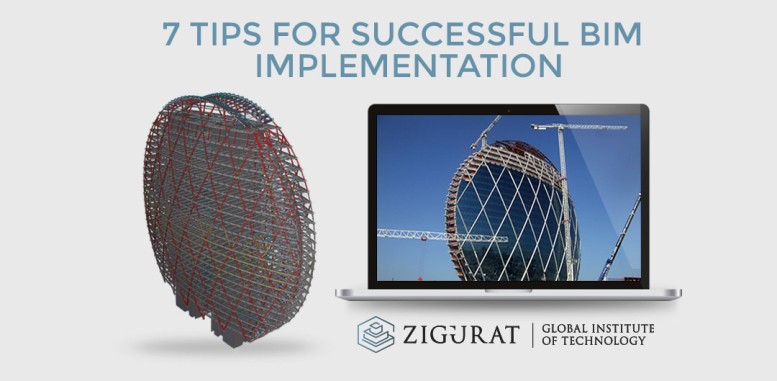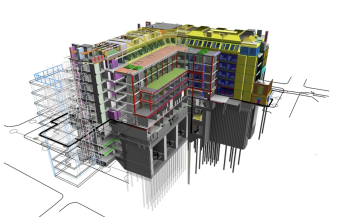Zigurat Global Institute of Technology
Blog / BIM & Construction Management
7 tips for successful BIM implementation
Categories

Are you considering a BIM implementation? We give you seven tips to ensure a smooth transition from a CAD-based workflow
Despite the popular belief that BIM is just about software usage, it is much more than that. As explained in Zigurat’s Global BIM Management Master's program, BIM can be integrated into a building’s entire lifecycle; it’s a methodology, from software, design and collaborative work to construction, ongoing operations, processes and workflows. To succeed in BIM implementation, there are several things that should be taken into account. In the article below, we take an in-depth look at 7 tips for a successful BIM implementation.

1. Have a plan
The "I" in BIM stands for "Information" and information is directly related to knowledge. Inform yourself about BIM as much as possible and determine the steps that you need to take to approach BIM. Going into BIM because it is popular right now without actually knowing what it is can do more harm than good and result in wasted time and money. It is helpful to set goals by writing out what exactly it is that you hope to achieve with BIM. This can be achieved by creating a structured BIM Implementation Plan (BIP) that sets out the software, roles, processes, and workflows that your organization will implement as you move forward.
2. Take the time to get it right
With how quickly the methodology is spreading across the industry right now, it's no wonder that people are rushing to learn BIM. I've heard stories of companies sending employees to take a basic course in Revit modeling and then being disappointed when their employees returned because they saw little or no change in the efficiency or productivity of their businesses. BIM implementation is more than just software, and in order to take full advantage of the methodology, you have to know how it applies to each phase of a project, what to expect from your team and what is expected of each stakeholder contributing to the project.
3. Get everyone on board
The key to BIM is the cooperation and collaboration that the methodology allows for. Without full buy-in from everyone involved in the project, the advantages of BIM are wasted. BIM can be implemented at every stage of a project, from design and construction through to facility management, operations and even the eventual demolition of the building. When every single discipline involved in the project is working in perfect harmony with one another is when the real savings of cost and time are realized.
Join the most comprehensive BIM management program in the world and learn how to create a BIM implementation plan for your business or organization!
4. Know your options
BIM can be applied to 2D/3D modeling, measurements, scheduling and planning, cost estimations and budgeting, energy analysis and efficiency studies, facility management and operations, infrastructure, mechanical, electrical and plumbing (MEP), structures, collision detection/resolution, and more. If you can think of it, you can probably do it with BIM. Knowing exactly what your options are, how to apply them, who you need on your team to accomplish them, and when to call in outside experts are all very useful skills in a BIM project.
5. Know what’s expected of your team
With so many possibilities in a project done with BIM, it is important to know what role each person on the team has and how to manage all of the information that is going into the project. This is why it is important to have a BIM Manager who knows what is expected, how to assign roles and how to organize the information in a legible way that makes sense for the specific project. Creating and following set style guides ensures that everyone on the project is contributing according to the standards of the firm, organization or government mandates.
6. Stay up to date
There are many major advancements currently being made with the BIM methodology and staying up to date with the latest ones not only makes you more marketable, but can improve your efficiency as well, resulting in savings that can be passed down to the building owner or developer and make you more competitive. The end goal is always to save on costs and resources and constantly updating your knowledge on evolving workflows will ensure your continued success. With the advancement of BIM and all of the useful data that it brings with it, fully-integrated “Smart Cities” may very soon be a possibility, and the market will reward those who are ready to work within this new paradigm. With that said, don’t go chasing every hyped-up “BIM flavor of the day” as there are also tons of people who are just trying to cash in on the uncertainty of the new methodology. When you’re actually working with BIM, it should be apparent what advancements will actually help to improve your workflows.
7. Learn from experts
Learning by trial and error is always possible, but at the cost of precious time and resources. The best way to learn anything is to be taught by an expert who has the perspective to know what is necessary to accomplish your goals. The only efficient way to know BIM inside and out is for someone who has the background and experience to pass the knowledge down to you. That's why all of the professors in our Global BIM Management Master's program are adjunct professors who work full-time in the industry. By bringing in experts who are thought-leaders and respected references in their areas of specialty, we are able to teach the skills that are necessary for our participants to be successful in a competitive international career market.




